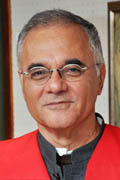 |
| Prof. Mahmood Mamdani |
|
“The Truth and Reconciliation Commission (TRC) accepted as legitimate the rule of law that undergirded apartheid. It defined as crime only those acts that would have been considered criminal under the laws of apartheid.”
This statement was made by the internationally acclaimed scholar, Prof. Mahmood Mamdani, when he delivered the Africa Memorial Lecture at the University of the Free State (UFS) last week on the topic: Lessons of Nuremberg and Codesa: Where do we go from here?
“According to the TRC, though crimes were committed under apartheid, apartheid itself – including the law enforced by the apartheid state – was not a crime,” he said.
He said the social justice challenges that South Africa faced today were as a result of the TRC’s failure to broaden the discussion of justice beyond political to social justice.
He said it had to go beyond “the liberal focus on bodily integrity” and acknowledge the violence that deprived the vast majority of South Africans of their means of livelihood.
“Had the TRC acknowledged pass laws and forced removals as constituting the core social violence of apartheid, as the stuff of extra-economic coercion and primitive accumulation, it would have been in a position to imagine a socio-economic order beyond a liberalised post-apartheid society,” he said.
“It would have been able to highlight the question of justice in its fullness, and not only as criminal and political, but also as social.”
He said the TRC failed to go beyond the political reconciliation achieved at Codesa and laid the foundation for a social reconciliation. “It was unable to think beyond crime and punishment,” he said.
He said it recognised as victims only individuals and not groups, and human rights violations only as violations of “the bodily integrity of an individual”; that is, only torture and murder.
“How could this be when apartheid was brazenly an ideology of group oppression and appropriation? How could the TRC make a clear-cut distinction between violence against persons and that against property when most group violence under apartheid constituted extra-economic coercion, in other words, it was against both person and property?”, he asked.
“The TRC was credible as performance, as theatre, but failed as a social project”.
Prof. Mamdani is the Director of the Institute of Social Research at the Makerere University in Kampala, Uganda; and the Herbert Lehman Professor of Government in the Department of Anthropology at the Columbia University in New York, USA.
Media Release
Issued by: Mangaliso Radebe
Assistant Director: Media Liaison
Tel: 051 401 2828
Cell: 078 460 3320
E-mail: radebemt@ufs.ac.za
20 July 2010
|